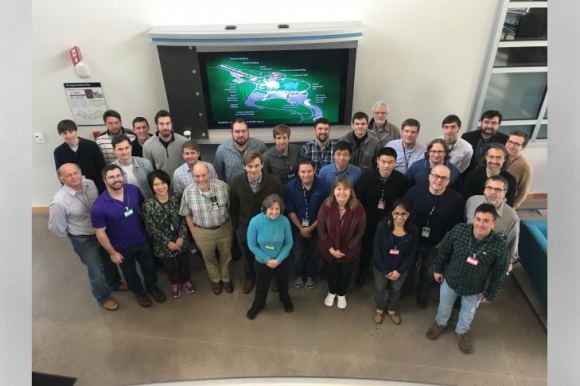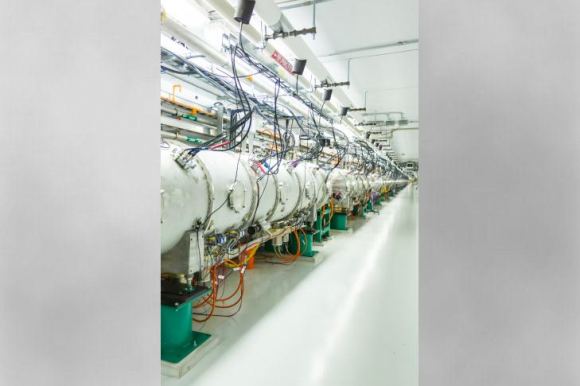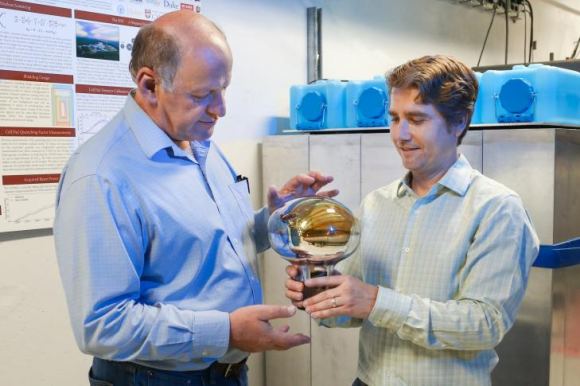Experiment Detects Mysterious Neutrino-Nucleus Scattering For the First Time
Neutrinos are one of the fundamental particles that make up the Universe. Compared to other types of particles, they have very little mass, no charge, and only interact with others via the weak nuclear force and gravity. As such, finding evidence of heir interactions is extremely difficult, requiring massive instruments located deep underground to shield them from any interference.
However, using the Spallation Neutron Source (SNS), a research facility located at the Oak Ridge National Laboratory (ORNL) – a international team of researchers recently made an historic discovery about neutrinos using an entirely different method. As part of the COHERENT experiment, these results confirm a prediction made 43 years ago and offers new possibilities for neutrino research.
The study that details their findings, titled “Observation of coherent elastic neutrino-nucleus scattering“, was recently published in the journal Science. The research was conducted as part of the COHERENT experiment, a collaboration of 80 researchers from 19 institutions from more 4 nations that has been searching for what is known as Coherent Elastic Neutrino-Nucleus Scattering (CEvNS) for over a year.

The COHERENT collaboration is the first experiment to observe coherent elastic neutrino–nucleus scattering. Their results confirm a prediction of the Standard Model and establish constraints on alternative theoretical models. Credit: COHERENT Collaboration
In finding evidence of this behavior, COHERENT has essentially made history. As Jason Newby, an ORNL physicist and the technical coordinator for COHERENT, said in a ORNL press statement:
“The one-of-a-kind particle physics experiment at Oak Ridge National Laboratory was the first to measure coherent scattering of low-energy neutrinos off nuclei.”
To break it all down, the Standard Model of particle physics indicates that neutrinos are leptons, a particle that interacts with other matter very weakly. They are created through radioactive decay, the nuclear reactions that power stars, and from supernovae. The Big Bang model of cosmology also predicts that neutrinos are the most abundant particles in existence, since they are a byproduct of the creation of the Universe.
As such, their study has been a major focal point for theoretical physicists and cosmologists. In previous studies, neutrino interactions were detected by using literally tons of target material and then examining the particle transformations that resulted from neutrinos hitting them.
Examples include the Super-Kamiokande Observatory in Japan, an underground facility where the target material is 50,000 tons of ultrapure water. In the case of SNOLAB’s Sudbury Neutrino Observatory – which is located in a former mine complex near Sudbury, Ontario – the SNO neutrino detector relies on heavy water for neutrino detection while the SNO+ experiment will use a liquid scintillator.

Super-Kamiokande, a neutrino detector in Japan, holds 50,000 tons of ultrapure water surrounded by light tubes. Credit: Super-Kamiokande Observatory
And the IceCube Neutrino Observatory– the largest neutrino detector in the world, located at the Amundsen–Scott South Pole Station in Antarctica – relies on Antarctic ice to detect neutrino interactions. In all cases, the facilities are extremely isolated and rely on a very expensive equipment.
The COHERENT experiment, however, is immensely smaller and more economical by comparison, weighing a mere 14.5 kg (32 lbs) and occupying far less in the way of space. The experiment was created to take advantage of the existing SNS accelerator-based system, which produces the most intense pulsed neutron beams in the world in order to smash mercury atoms with beams of protons.
This process creates massive amounts of neutrons which are used for various scientific experiments. However, the process also creates a significant amount of neutrinos as a byproduct. To take advantage of this, the COHERENT team began developing a neutrino experiment known as “neutrino alley”. Located in a basement corridor just 20 meters (45 feet) from the mercury tank, the thick concrete walls and gravel provide natural shielding.
The corridor is also fitted with large water tanks to block out additional neutrinos, cosmic rays and other particles. But unlike other experiments, the COHERENT detectors look for signs of neutrinos bumping into the nuclei of other atoms. To do this, the team outfitted the corridor with detectors that rely on a cesium iodide scintillator crystal, which also uses odium to increase the prominence of light signals caused by neutrino interactions.

SNS Beamline 13, where protons are slammed into atoms of mercury to release a slew of energetic particles. Credit: ORNL/U.S. Dept. of Energy/Genevieve Martin
Juan Collar, a physicist from the University of Chicago, led the design team that created the detector used at SNS. As he explained, this was a “back-to-basics” approach that did away with more expensive and massive detectors:
“They are arguably the most pedestrian kind of radiation detector available, having been around for a century. Sodium-doped cesium iodide merges all of the properties required to work as a small, ‘handheld’ coherent neutrino detector. Very often, less is more.”
Thanks to their experiment and the sophistication of the SNS, the researchers were able to determine that neutrinos are capable of coupling to quarks through the exchange of neutral Z bosons. This process, which is known as Coherent Elastic Neutrino-Nucleus Scattering (CEvNS), was first predicted in 1973. But until now, no experiment or research team has been able to confirm it.
As Jason Newby indicated, the experiment succeeded in large part thanks to the sophistication of the existing facility. “The energy of the SNS neutrinos is almost perfectly tuned for this experiment—large enough to create a detectable signal, but small enough to take advantage of the coherence condition,” he said. “The only smoking gun of the interaction is a small amount of energy imparted to a single nucleus.”
The data it produced was also cleaner than with previous experiments, since the neutrinos (like the SNS neutron beam that produced them) were also pulsed. This allowed for the easy separation of the signal from background signals, which offered an advantage over steady-state neutrino sources – such as those that are produced by nuclear reactors.

Professor Yuri Efremenko of the University of Tennessee–Knoxville and Jason Newby of ORNL – two members of COHERENT. Credit: ORNL/U.S. Dept. of Energy/Genevieve Martin
The team also detected three “flavors” of neutrinos, which included muon neutrinos, muon antineutrinos, and electron neutrinos. Whereas the muon neutrinos emerged instantaneously, the others were detected a few microseconds later. From this, the COHERENT team not only validated the theory of CEvNS, but also the Standard Model of particle physics. Their findings also have implications for astrophysics and cosmology.
As Kate Scholberg, a physicist from Duke University and COHERENT’s spokesperson, explained:
“When a massive star collapses and then explodes, the neutrinos dump vast energy into the stellar envelope. Understanding the process feeds into understanding of how these dramatic events occur… COHERENT’s data will help with interpretation of measurements of neutrino properties by experiments worldwide. We may also be able to use coherent scattering to better understand the structure of the nucleus.”
While there is no need for further confirmation of their results, the COHERENT researchers plan to conduct additional measurements in order to observe coherent neutrino interactions at distinct rates (another signature of the process). From this, they hope to expand their knowledge of the nature of CEvNS, as well as other basic neutrino properties – such as their intrinsic magnetism.
This discovery was certainly impressive in its own right, given that it validates an aspect of both the Standard Model of particle physics and Big Bang cosmology. But the fact that the method offers cleaner results and relies on instruments that are significantly smaller and less expensive than other experiments – that is very impressive!
The implications of this research are sure to be far-reaching, and it will interesting to see what other discoveries it enables in the future!
Further Reading: Science, Oak Ridge National Laboratory
The post Experiment Detects Mysterious Neutrino-Nucleus Scattering For the First Time appeared first on Universe Today.
